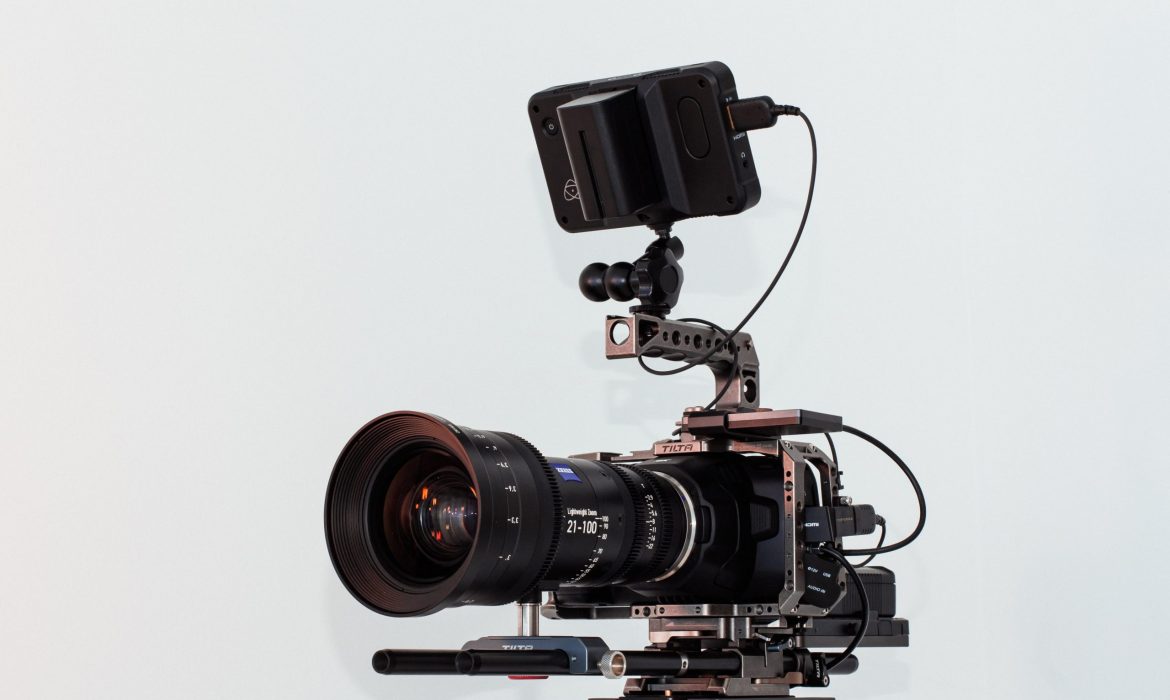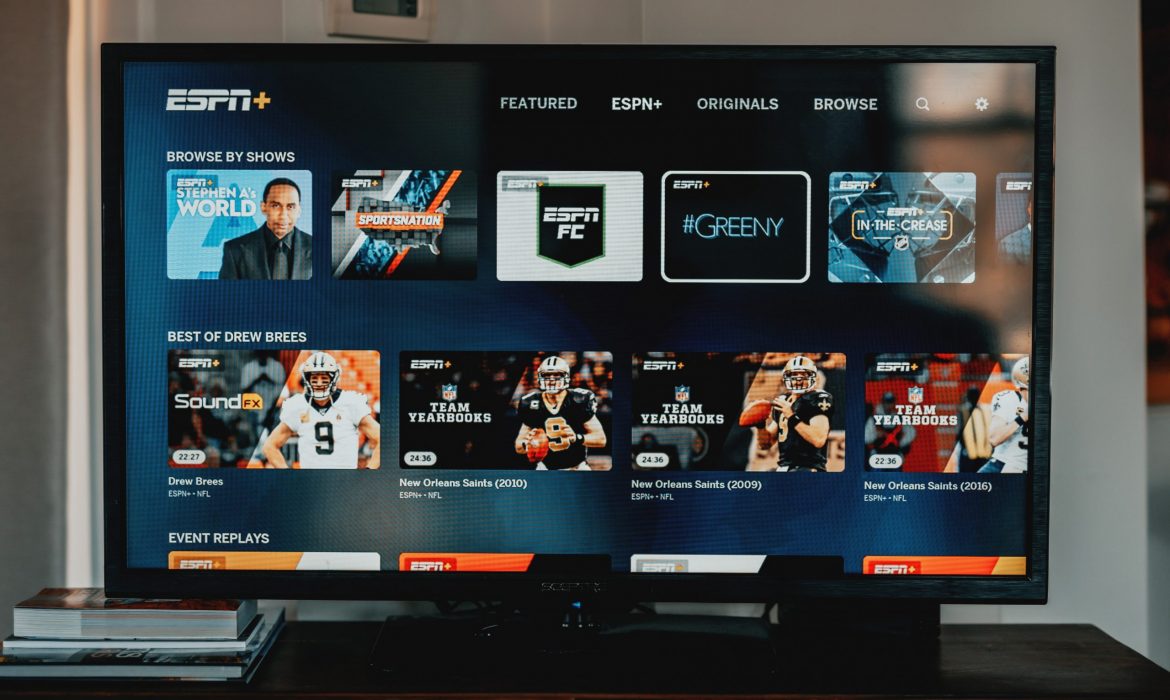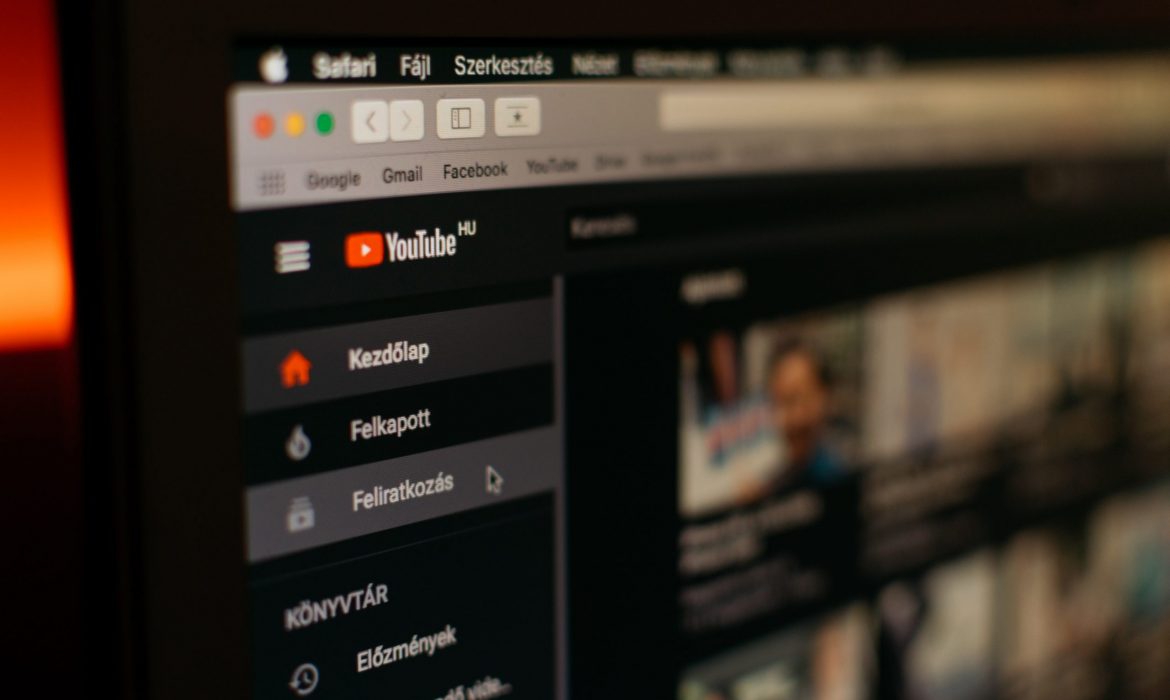Your essential read if you’ve ever wondered how to make traditional TV cool again!
In the US, adults are spending more and more time with different kinds of digital media[1], while their attention is also shifting from traditional TV to PCs, and smartphones and tablets connected to the web.
What’s interesting is that while there is an enormous variety of traditionally broadcast TV channels to choose from (a monthly average of 206 channels according to Nielsen research), US adults only actively watch 20 of them[2]. In other Nielsen data for US adults, while TV still rules people are using a broader range of devices for home entertainment, with apps and the web now hot on the heels of TV. The total time spent on other devices now outweighs time spent watching traditional TV.
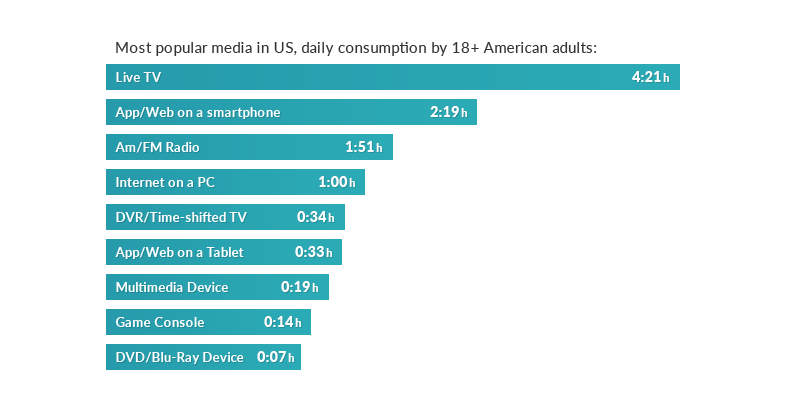
If you look at the behaviour of younger viewers in particular, what’s evident is that Generation Z (12-20 year olds) consume the smallest amount of traditional TV, either when live or time shifted/recorded. Arguably, this is the effect of a new and younger audience becoming bored (or simply not accustomed to) traditional TV’s linear approach, which might be a challenging argument to accept if you work in broadcast TV.
To help you to understand, let’s look at this analogy. Nowadays, traditional TV is like a middle-aged guy trying to gain popularity on Snapchat – the technology feels the same, the rules are clear, but somehow it simply doesn’t work for him. What he says and does is simply not attractive enough for the audience on that platform. (Believe me, I feel like this guy at times as I don’t always understand the buzz surrounding Snapchat.)
Back in the broadcasting world, you may be more than conscious that new ways of consuming media are coming. You might feel they’re already here. Yet, with huge resources, varied schedules and all the broadcasting technology at your disposal, perhaps you’re still left wondering why traditional TV isn’t as attractive as it was? Perhaps you can’t quite put your finger on why this is the case.
Let’s take a closer look at some of the opportunities and threats below.
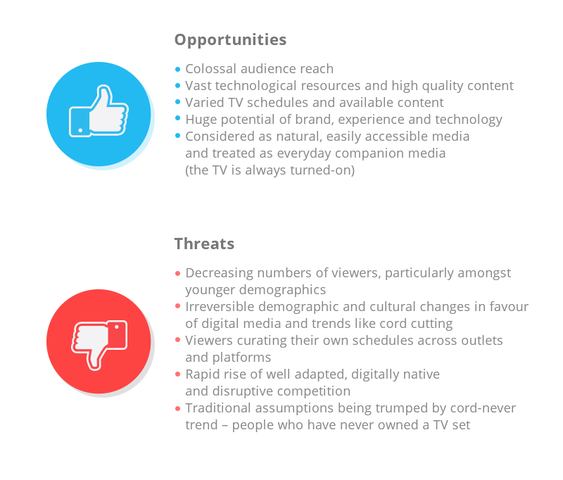
What’s common amongst the above threats is the impact of the internet and the smartphone. Viewers now have more flexibility – they can watch and interact with digital, web TV and OTTs in any manner they like, where and when they want, and on the device of their choosing.
Why should viewers miss the ol’ set-top box? So, is this the end of linear TV as we know it? It’s too early to jump to this kind of conclusion. For sure, there are now many more options to traditional TV and improvements that linear broadcasters should make to stay in the game.
Let’s dive in and check out six ways you can sharpen your focus to stay alive in this fast-paced, digital-first world.
- Make the web your friend and ally
- Use your TV brand as leverage
- Your experience is your advantage
- Retain your loyal viewers
- Work across platforms
- Conversations – it takes (at least) two to tango!
First things first, if you haven’t done so already, make your brand more visible online by expanding your social media presence. Take time to reconsider your options, making an audit of your efforts to date to identify what’s worked and what hasn’t.
When relaunching your social media presence, have a video content strategy in place that puts you in a position to start streaming and producing videos for social channels. Streams and social videos make for highly engaging web content and, as a broadcaster, you are ideally placed to create a constant stream of such content. To do so, choose social video production tools and platforms that will fit your needs, and ones that will enable you to stream and produce videos from live content and any archival content you want to use.

Live streams and videos are undoubtedly the most engaging types of content. When checking Facebook streaming results for one of our Tellyo clients, we learned that it is possible to create up to 400 interactions per 1,000 fans with live video, while images were able to reach only 6 interactions per 1,000. For further interesting stats, check out the case studies section on our website.
Having a strong and recognisable brand is unbelievably helpful online – it will help you to stand out. If your logo is well known, you should remember to place it on your video content, so that when this spreads around the internet you get the brand recognition you deserve. With a little bit of luck, many viewers will trace your quality content back to your channel or Facebook page.
Being experienced with video production and everything broadcasting related is a huge advantage over your competitors. Being able to create TV-grade video content, while having an experienced team and professional equipment are all strong assets. However, these assets aren’t enough to be successful on the web and in the social media, but they will help a lot. You can always talk to us here at Tellyo about how to combine your experience with an advanced, social video production platform such as ours.
Have you ever heard of the Pareto principle[4]? Better known as the 80/20 rule which states that 80% of the effects come from 20% of the causes. Translating this into broadcast language – it means that 20% of your audience is responsible for 80% of your views. Therefore, if you want to be successful in social media, play to your core audience. Let them know that soon they will be able to watch their favourite shows and events via other media as well.
Remember that social media isn’t monolithic – it’s decentralised and each platform has its own properties. You shouldn’t copy and paste your strategy from one channel to another. For example, if you decide to stream content then use YouTube, Facebook or Twitter, but only YouTube will be a good place as a platform to host clips for a longer period. Facebook will give you a big audience and visibility initially, but people will not find your videos once they vanish from timelines.
Your audience has a voice, and it will use it. In comments, emails and chats, they will use each possible channel to give you their opinion about your content. And that’s a good thing – a gold mine of interactions and engagement to treasure. You should work hard to maintain these conversations. Be active: answer questions and ask for opinions.
It’s too early to abandon ship
Traditional, linear TV still has a lot to offer audiences. But the TV landscape in the next 5-10 years will be dramatically different to what we have now.
In the meantime, there is likely to be many more advances and disruptive changes. Now is your chance to decide whether you want to be part of it or not.
Improve your social media stream with different content types
Remember when you had to buy an actual newspaper to see TV schedules? The good old days! Today’s world is completely the opposite, however: TV series, entertainment shows and sports events tempt you from each corner of the internet to watch them.
For broadcasters, this means you cannot simply wait for the viewer to come, because they have too much to choose from and too many other distractions. This leaves many broadcasters struggling for attention – a battle that’s impossible to win unless there is a willingness to adapt and offer more than traditional broadcasting.
Why adapt and offer something different? Let’s take a look.
The shift in attention
The data is ruthless: Gen Zers are rejecting traditional TV in favour of digital media[1]. There’s no doubt, change is in the air and there seems to be no way to reverse it.
But it’s not all doom and gloom – broadcasters just need to be prepared to try different mediums, but also to confront the demands of a different, more picky audience. The truth is that losing a viewer on the web is extremely easy, with potential viewers literally a click away from opening a new tab and moving their attention to a different place.

Broadcasters, especially those with experience in linear TV, are having to deal with this new shift, as well as learn new tools to manage the situation.
Social streaming is a great new tool in the box, but is it enough to grab attention for sustained periods of time? Especially when Gen Zers are notoriously less focused and easily distracted. The great news about Gen Zers though is that they are excellent at multitasking[3], which means they can watch a live stream, write comments and read articles at the same time!
So, if you decide to adapt to this new generation and the shift in attention, what are you going to offer? We already know that a social broadcast shouldn’t be a singular event. But what else should be part of the social broadcasting ecosystem? Next, let’s take a look at the essential ingredients.
The essential ingredients for successful social broadcasting
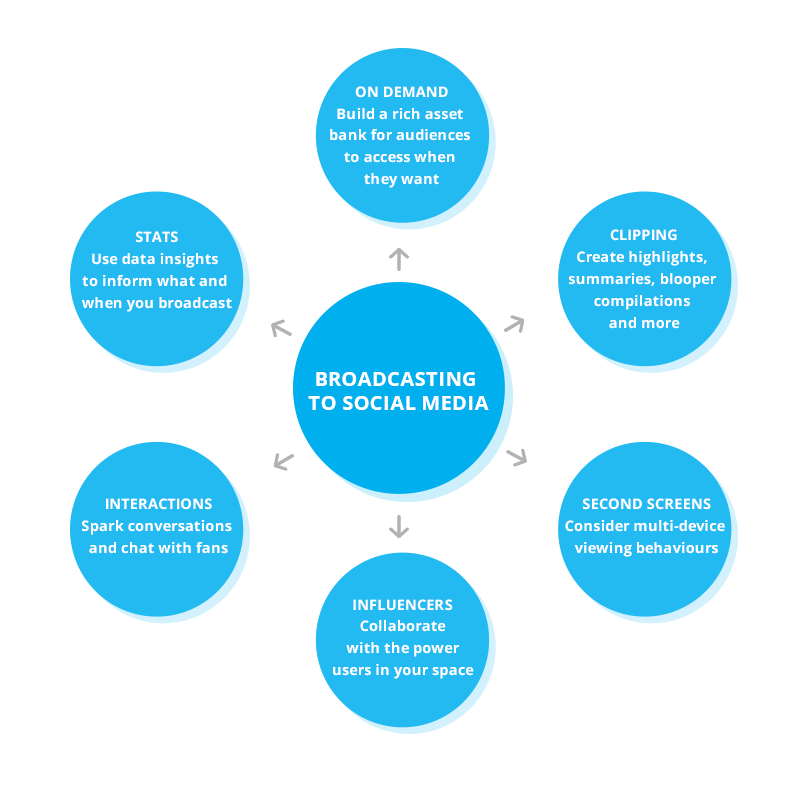
Clipping
This seems like a no-brainer, but it’s worth repeating. When streaming to a social media channel such as Facebook, keep creating and sharing bit-sized clips for those unable to watch the live stream itself. This is great for a number of reasons, as clips will help you to:
- Gain brand visibility inside and outside of your fan base.
- Increase all vital KPIs – views, reach, number of fans etc.
- Develop a rich bank of content you can upload to services like YouTube, Facebook or your own on-demand platform.
- Meet the demands of second screeners – who might be watching your live stream and catching/commenting on your clips, too.
Don’t avoid second screens – provide one!
To ‘second screen’ is to watch content on your TV and, at the same time, use a laptop or smartphone (the second screen) to check what’s going on in your social feeds, to message friends, use an app etc.
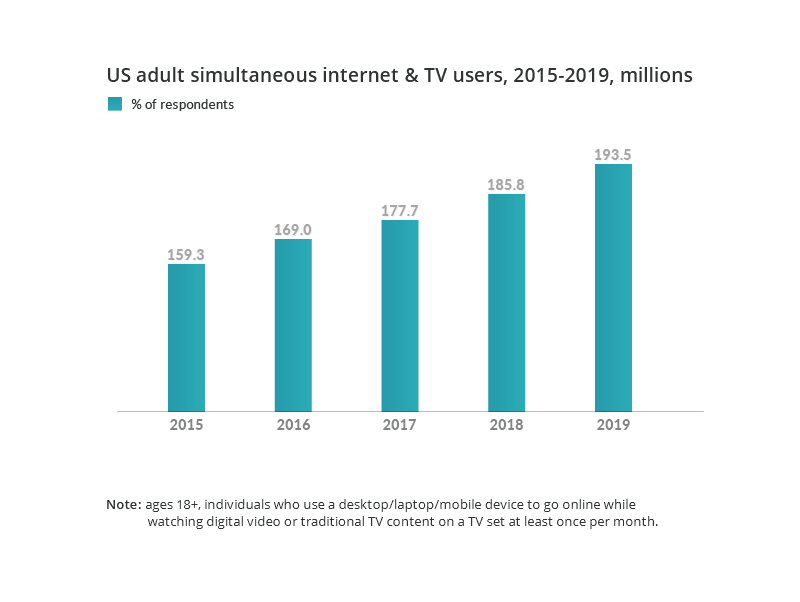
What’s in it for you? Out of 177 million second screeners in the US, 74% of viewers are interacting with unrelated content they see while watching a main event[4]. Your goal should be to make these people eager to see your content, instead of anything else.
Many second screeners are using Twitter to interact with their friends while watching a TV broadcast. They prefer to tweet, because the micro-blogging platform is quick and known for its promptness. Twitter has a 6% higher interaction rate for cross platform viewing among other social media platforms.[5]
The lesson to learn: While broadcasting, whether via a TV channel or a social stream, you should interact with your audience using other platforms. Use Twitter, Facebook or Snapchat and get involved with your audience. If you have your own mobile app, don’t hesitate to use push notifications to grab attention.
Mobile approach
Writing about the necessity of having a mobile app is soooo 2010, right? Well, it isn’t if you still don’t have one or you’re not using it properly. Mobile apps are a great marketing channel, especially if you have enough resources to keep it in good shape and your fan base is big enough to give you a good return on your investment.
How can you use a mobile app while being a broadcaster? You would use it just like any other marketing channel. But it has particular power if you treat it like an extra screen, content distribution tool and video streaming extension.
If you’re broadcasting whole TV programmes, include a calendar in the app, so your viewers can schedule reminders. If you’re streaming singular events, keep your fan base excited with news stories and premium video content available for app users only.
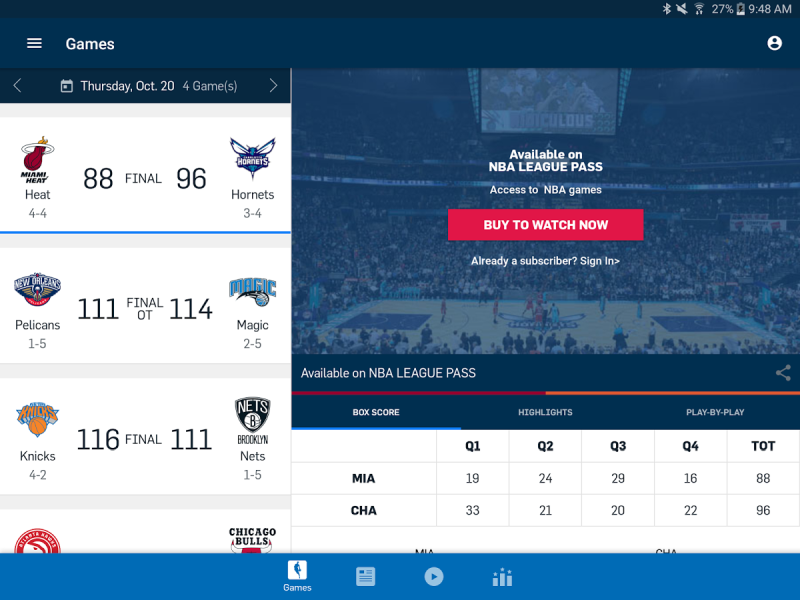
The NBA and NFL have both developed really good apps, providing live streams, video content, news and stats.
Stats and crucial details
Statistics and big data are extremely important, especially if you work in the sports broadcasting industry. Data is a gold mine for creating extra content for fans, such as stats, visualisations, comparisons, infographics etc… the list could go on.
Screen the data while broadcasting, but also create graphs, graphics and charts to publish on different social channels. Well prepared content will remain evergreen and live for a long time after its original use.
Collaborate with influencers
Collaborations with influencers in your space are a very modern solution. Essentially, by working with the movers and shakers in your environment, however big or niche they might be, will give you extra credibility and position your brand as an expert in your field.
You can collaborate with influencers in many ways: asking them for pre/post broadcast comments, involving them as expert panelists during streams, or by creating in-depth content in partnership. An influencer will provide expertise and give you a very specialised point of view.
Internet = social media
98% of people using the internet are social media users at the same time[6] – and there seems to be almost no life beyond Facebook, YouTube, Twitter or Weibo.
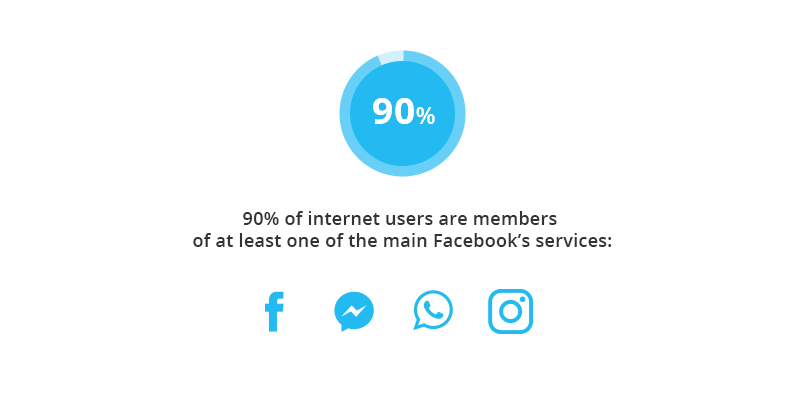
What this means is that your potential viewers are already on the web and probably on social media. As they’re already in these online spaces, you just need to reach them and spark interactions.
The good news is that potential viewers are likely to go where the good content is. So, alongside your awesome social broadcasts, share clips, create cool GIFs, publish polls, and ask your audience what they think and how they feel towards the content you’re sharing and what you’re saying – all the while encouraging conversations.
Go the extra mile!
Creating a wide range of versatile content can be time consuming and challenging. But, if done well, extremely rewarding at the same time. You might not have the budget and resources to cover all of the above solutions. But doing the social broadcast is surely the first step to take. Everything else is up to you!
[2] Nielsen Total Audience Report, Q1 2017. Daily time spent on TV, hr:min (Live+DVR/Time-Shifted): Generation Z, 2:18; Generation X, 4:38; Baby Boomers, 6:42
5 sports clubs keeping fans excited with creative video content
Sports fans are a unique bunch. They consist of people able to name an entire trophy-winning team from back in the 60’s, to the sort willing to go to another continent to see their team, sometimes in the knowledge they could get heavily beaten.
Thanks to the development of the web, the last 15 years have enabled the most popular clubs to get closer to many new fans – now only a click away. However, the majority of these new fans might never get a chance to see their favourite team in person. This situation is making club owners and marketing managers face a new challenge: how to maintain the interest of millions of fans who are living thousands of miles away? These fans are often unable to visit the stadium to see games or watch on TV, while just selling merchandise to them is far too short-sighted as a strategy.
Interesting read: Reach new fans by going social
To nurture fans, and keep them engaged and committed, surely you need to give them something more? The answer for many clubs is to make all fans across the globe feel like part of a wider community. But how? This is when creative video content and social media come into play!
In this blog, I’ll walk you through the best examples of video content produced by some of the most popular sports team in the world. But, before we start, let’s find out…
…how are fans consuming sports content?
The stats tell us that 53% of global internet users watch sports coverage or highlights. That’s a tremendous amount of people – with 39% choosing PCs and laptops to see their favourite teams plays; while 36% watch on mobiles and 15% on tablets[1].
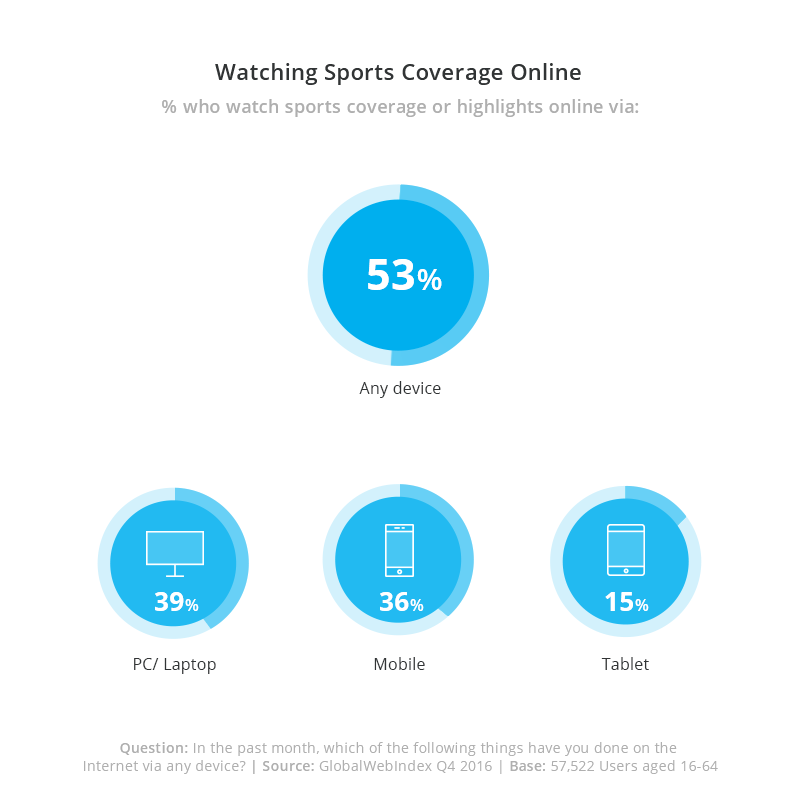
It’s pretty obvious that internet users worldwide are looking for sports content and using a range of devices to do so. So, it’s worth adjusting your content to fit different screen sizes, as well as the aspect ratio requirements of each social platform.
Right, let’s now look at some cool examples of unique content, created by popular sports clubs.
AS Roma (Italy, Serie A)
The Italian football club from Rome is well known around Europe. But their fan base is smaller than other, top-notch clubs like Real Madrid or Chelsea. However, their efforts to create a comprehensive club TV channel is impressive. It’s well worth a mention here.
AS Roma offer their own traditional TV channel, but it is also available through their website for fans outside of Italy. It provides info about daily life at the club – training updates, chats with guests, replays of historical games and a frequent look back at the club’s legendary players. Live broadcasts run from Monday to Saturday in the morning.
Roma also offer a paid, premium version – called Roma TV+. It includes live video content, national and international games, and an on-demand service featuring past games and highlights.
Overall, the club has put in a lot of effort to make their fans well informed about the club and everything going on around it. Even the youth section has its own, dedicated programme – Punto Giovani. You can see that content produced for Roma fans is top quality, with programme specials often involving players as hosts and guests.
New England Patriots (United States, NFL)
While the NFL is huge, its broadcasting deals are complicated. For example, not all games are broadcast nationally on TV. Usually, there’s only one game shown nationally in each set of games – on Thursday, Sunday and Monday nights. The rights to stream games in the current season have been signed by five linear TV channels. At the same time, these channels are streaming games through the internet thanks to their paid platforms. Because of these licenses, clubs don’t have ready-made match content to show to their fans and can find it extremely hard to keep fans updated as a result.
Despite the above, the New England Patriots have really upped their game. Through their official website and YouTube channel they show video content such as game highlights, press conferences, and interviews with players and coaches. Videos are largely produced by external broadcasters, not by the club itself. However, the club’s YouTube channel is its home for in-house produced content, with Patriots players often playing an important role.
Fans get to see many humorous and interesting programmes involving players, such as visits to hometowns or lessons in game tactics.
The Patriots is a great example of content produced on an in-house budget but with great production values and interesting stories to tell. Fans can meet their idols and learn about their interests. This way, the New England Patriots are keeping their fans engaged with the club and its players, not only during games.
FC Barcelona (Spain, La Liga)
FC Barcelona is probably the most popular club in the world (sorry Manchester United!). While this is great news for the club, it presents a challenge to keep global fans interested all the time.
Obviously Barcelona games are more accessible – such as La Liga, Copa del Rey, Champions League, abroad tours etc – all of which are more widely broadcasted by many TV stations and digital broadcasters. The club itself also produces tons of its own video content. What’s worth of mentioning is that this content is not only dedicated to the first team.
You can see women’s games in the Spanish and Champions League, second team training sessions and youth academy football via the La Masia complex. Also shown are Barca fans having fun during matches, interviews with players and lots of Lionel Messi!
Barca also use YouTube to broadcast various events, like games involving the Barca Legends (a joy to see Ronaldinho, Kluivert and Rivaldo playing together!), as well as club updates such as contract renewals by key players.
The YouTube channel is updated frequently and loaded with action. While it’s unable to stream premium content because of broadcasting deals, the Barca media team do an amazing job and still have plenty to show. And fans around the world love it!
Boston Celtics (United States, NBA)
The Boston Celtics are the most successful team in the history of the NBA, responsible for 24.3% of all championship titles[2]. While the Celtics are unable to stream games to its Facebook feed or YouTube channel – because the rights are reserved for premium, paid services – they still have a lot to show.
The Celtics host video content on their official website, YouTube channel and Facebook page. Even though there are no live games, you can find a lot of action, highlights and interviews with players, straight from the pitch. However, this is what most teams are doing, so what Celtics content really stands out?
Specifically, the Celtics offer a lot of videos to promote their activity amongst its community of supporters. They help veteran soldiers, and promote health and fitness among its youngest fans. This is a great way to show that the NBA team is not only about money, contracts and breaking records, but it has strong community links built around the club.
However, my favourite type of Celtic’s video is the one called ‘Bad jokes’. It’s a simple format that shows paired players telling each other bad jokes! It’s completely silly, but at the same time just nice and refreshing to see professional sportsmen having fun. Priceless!
Canadiens de Montréal (Canada, NHL)
Because the NHL’s streaming rights – just like the NFL or NBA – are usually reserved for the biggest players in broadcasting, the league’s clubs tend not to produce content of their own. Most videos from popular NHL teams are just interviews or highlights – which is cool. But Canadiens de Montréal are different!
Someone in the Canadien’s video production team obviously has a lot of great ideas on how to involve players and bring some quality to their content. Despite the lack of game action and highlights, their YouTube channel is an extremely engaging place. They’re using multiple and diverse formats to reach their fans, and it’s working – they have the biggest number of YouTube subscribers amongst all NHL teams.
So, what’s so good about the Canadien’s video content?
If something seems crazy but it’s working – it’s not so crazy!
Sports video content is not only about the games!
There’s no doubt fans watch games for the thrill and emotion of live action – the scoring of a goal or winning a game. But there’s still a lot to show outside of the games. Digital platforms like YouTube or Facebook are perfect to show content aside to a club’s more formal digital roadmap.
A richer array of content can help larger clubs to build a positive PR image, increase reach, monetise viewership independently from major broadcasting contracts and keep the community up to date with club life.
Similarly, content produced by smaller clubs can draw in new fans, nurture an existing fan base and monetise digital content. Perhaps this sort of content will be a first in their history for many smaller clubs.
No matter how big your club or organisation, having this kind of video content will offer an amazing addition to current live broadcasting arrangements and existing marketing activities. Simply take look around your environment and explore interesting things going on. I bet there’s a lot of cool content you can learn from and begin to show yourself!
5 convincing reasons you should stream esports
If you were to ask someone – what’s your favourite sport? – the answer would likely be one of the following: football, basketball or cricket. However, this status quo is changing even as I write this blog. That’s because we have a new player in town: esports!
Esports (electronic sports) is best described as competitive, multi-player video gaming. Puzzled? Not really convinced by this whole gaming thing? Here are five reasons to change your mind. By the end of this article you’ll be considering your options!
#1 Gaming is mainstream
Believe it or not, gaming is mainstream. No longer a hobby of geeky teenagers (if it ever was), it is one of the most popular ways to spend leisure time – next to watching TV, reading books or actively taking part in sports.
According to research, 67% of US households own a device that is used to play video games.[1] To compare – 58% of American households has one or two televisions, and 39% three TV sets or more[2] (obviously with some overlap between these two figures).
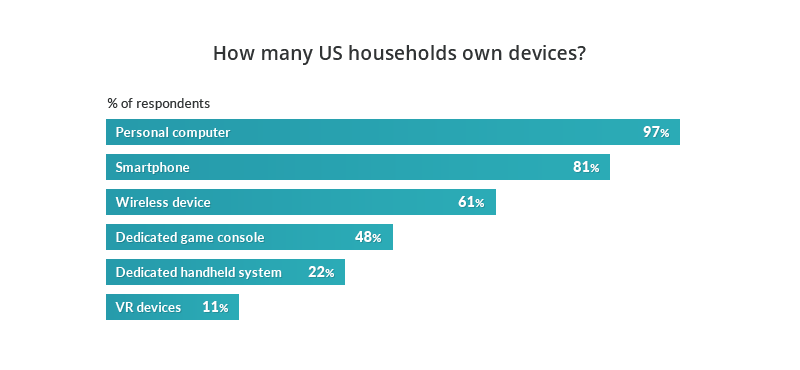
If you also look at the above device ownership stats, these point to changing trends in the tech used for leisure and entertainment. Traditional TV is also on the out as the cord cutting trend continues.
Gaming is part of these wider trends – an obvious example being a TV set used for gaming rather than for watching prescribed TV stations.
All around us we can see how gaming itself is more and more visible in media and culture. Think movies (Resident Evil, TRON, Warcraft, Wreck-It Ralph), magazines (thousands of titles around the world), TV series (frequent video games references in Futurama, South Park, Stranger Things, The Big Bang Theory) and even the advertising world. Game developers are not only buying adverts in digital media, nowadays you can see their ads on mainstream TV as well. The list could go on and on.
To cut a long story short – gaming is everywhere and it’s only just beginning!
#2 Esports stats are BIG
Esports events attract colossal amounts of people – both offline and online. Fans include a large proportion of millennials and Gen Zers, both demographics often difficult to access
Esports events attract colossal amounts of people – both offline and online. Fans include a large proportion of millennials and Gen Zers, both demographics often difficult to access. But research also highlights more surprising fan stats – they are often high earners, 38% are women and 58% of fans over 25 have children of their own.[3].
There are multiple leagues and tournaments focused around the most popular online games, like Dota 2, Hearthstone or FIFA and the PES series. Thanks to sponsors, esports players and teams are competing in big venues to massive audiences (both at the venue and online) and for serious money. Figures from SuperData Research suggest that $662million of sponsorship money was injected into esports during 2016[4].
In 2017, at the annual International Dota 2 Championships event in Seattle, players won prizes totalling… $24,687,919! [5]
One of the most recognisable esports events in the world – the Intel Extreme Masters (IEM) – engages thousands at the actual event and millions more during digital broadcasts. Held in 2017 in Katowice, Poland, organisers claim that the event was the world’s biggest esports event in history[6].
Here are some stats from the IEM event, which was mainly focused around League of Legends (LoL), Counter Strike: Global Offensive (CS:GO) and Starcraft II.
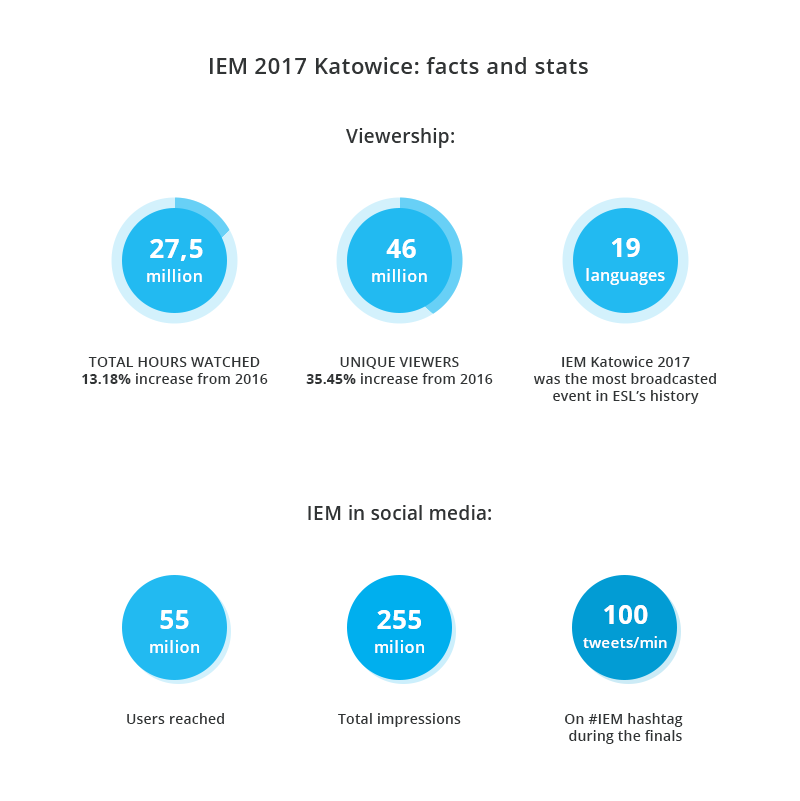
Just for comparison: Donald Trump’s 2017 inauguration was watched by 30.6million TV viewers, so 10 million more viewers watched IEM’s esports event.[7]
#3 Natively digital and hugely dynamic
With all the action taking place online, esports are natively digital – a natural environment for gaming and related content.
The biggest digital space in the esports streaming world is Twitch.tv – a digital broadcasting platform that specialises in showing content produced by gamers, for gamers. Bought by Amazon in 2014, Twitch is the first choice for players who want to stream their gameplays and even earn money from donations from fellow players. It is undoubtedly the most popular among players, but sometimes more suited to experienced insiders already familiar with the gaming world.
Linear TV stations are increasingly seeking a piece of the action. ESPN, BBC, SkySports and Poland’s Polsat are amongst the traditional broadcasters investing in the dynamic esports market in some way: streaming events or distributing related content online. These linear broadcasters are proving savvy in the way they’re using digital platforms, such as dedicated web pages and social media, to support their efforts and engage the esports audience. They understand that esports are digitally native and any supporting content must be digital as well. It’s as simple as that.
#4 Video content is integral
Digital streaming platforms like Twitch are undoubtedly spearheading the popularity of esports. What’s also really interesting is that gamers like to watch other gamers; while fan audiences are on the rise due to the exciting content on offer. Watching can be a roller coaster of emotions, just like every other sport, and the passion of fans is obvious.
Video is integral to this and YouTube is an extremely popular place for both gamers and fans to watch esports video content. Here are some interesting insights from Google:
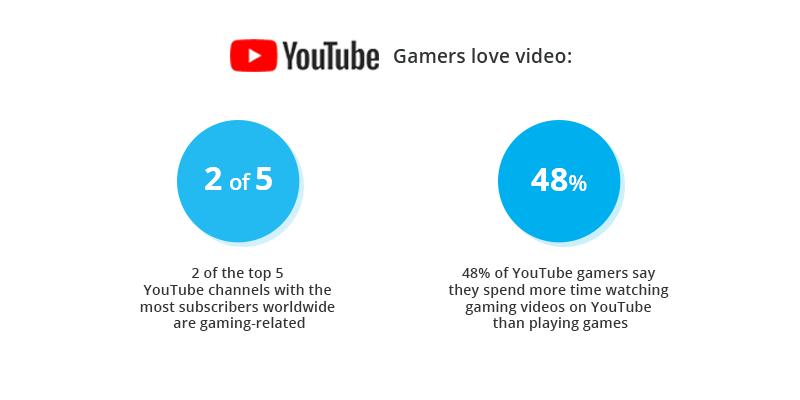
#5 A growing and engaging market
The value of the global video game market reached over $101billion in 2016 and will hit $128billion+ by 2020[8]. These staggering figures include PC, console and mobile games and point to one thing – people are simply crazy about games! More and more people are spending time and money to play them.
This isn’t a passive market though. Esports fans and players are highly engaged, keenly watching what’s going on in esports, following their own favourite players and teams. Esports are also very interactive – when playing and watching people chat, comment and interact, becoming part of a community of like-minded fans.
So, while they are interested in the most popular Triple-A titles and online games, fans will also be watching esports in their feeds, or practicing their own skills to develop as a gamer, or publishing their own gaming videos as a YouTuber.
The ball is in your court
Beyond doubt, esports is a hot topic. It involves millions of people playing, streaming and watching. The numbers are often staggering and, in many cases, the popularity of this kind of digital entertainment has already exceeded the popularity of ‘analogue’ sports. This represents a huge opportunity for sports broadcasters to get involved in this nascent market, while it’s still fresh and there’s still time.
[1] Source 1 , [2] Source 2, [3] Source 3, [4] Source 4, [5] Source 5, [6] Source 6, [7] Source 7, [8] Source 8
8 common live streaming mistakes that will create a horror show
Let’s face it, Halloween is a lot of fun. But only because it represents horrors that are not real. However, in the broadcasting industry real nightmares can happen, especially when live streaming to social media.
(By the way, have you seen the new Tellyo already?)
In this post, I’m going to run through the most common mistakes that will ruin your stream and scare off your audience.
Mistake #1: Being unprepared for technical difficulties

No matter how cool your event is, there are dozens of ways technical issues can wreck your stream. You can’t avoid equipment failure, nor repair an unpredictable internet outage. But you can think about providing alternative streams for users who are unable watch on Facebook or YouTube, for whatever reason. The same goes with streams at different qualities – depending on bandwidth, some users may want to skip 1080p and use 480p instead.
Think of alternatives to ensure your audience receives a broadcast one way or another.
Mistake #2: Not planning for when social becomes unsocial

When streaming content to platforms like YouTube, Twitter or Facebook you probably want to have as many viewers as possible, right? If so, the more people you attract, the more likely it is you’re going to draw the attention of people not always behaving properly or nicely. Trolls will be trolls, spammers will be spammers – but you must not let them take charge in a public chat or in your comments section. Put in place a moderator who can keep your broadcast free of these kinds of ‘users’.
The web is full of terrors trolls. Protect your audience from them.
Mistake #3: Failing to fill the gaps

For every single digital broadcaster who’s streaming live sports – remember half time!
People will be watching your content for entertainment. When nothing is happening during the breaks, show them something. Think along the lines of previously prepared highlights, bloopers, statistics or interviews with players. Otherwise your audience will open a new tab to scroll their Facebook feed or to watch a music video on YouTube. Simply put – you’ll lose them.
[bctt tweet=”You can’t afford to bore your audience, so provide them with entertainment!” username=”TellyoTV”]
Mistake #4: Forgetting to chop and cut… content

While live streaming, don’t forget about the people not able to follow your live stream, but who might be interested in what’s going on. Independent from your live broadcast, you should always clip and share highlights – such as goals, dunks and epic fails. This way, fans unable to catch the live stream can stay updated on what’s going on, and you can gain some extra views and reach.
Don’t stop creating content – the more clips you share, the bigger your audience will be.
Mistake #5: Not sending the memo!

No one will show up to your stream if you:
- Forget to post announcements before the actual event
- Plan the announcements too early or too late
- Spam your audience with waaaay too many announcements
You must remember to remind your users that you have a planned event, and make sure they are well informed about it.
Did you know that using Tellyo you can create Facebook announcement posts? These allow users to set reminders for events. How cool is that?
Mistake #6: Falling short when the end is nigh

The live broadcast shouldn’t be a singular event. It should be always preceded by announcement posts before the stream begins and not only on your chosen broadcast platform. During your broadcast, it’s also extremely important to produce short clips with highlights and replays, which will help drive new viewers to the live stream. Finally, after the broadcast, it’s your time to shine again – create highlights with summaries, clip compilations, top 5 plays etc.
Doing so, you will extend the broadcast from a one-off event to a longer, richer series of events focused on your main stream. Guess which one will attract more attention and viewers?
Tired of those scary horrors already? Try a love story instead!
Mistake #7: Being a silent (and creepy) administrator!

This is the face of someone who is streaming content to social media, but doing nothing more. He’s not taking part in discussions in comments section, he’s not answering questions, he’s not producing valuable content in the meantime and he’s definitely not a good example to follow.
Don’t be this guy!
Mistake #8: Missing your Frankenstein moment

Don’t forget to be like Frankenstein and bring your old stream alive again. To do so, simply make the video content available to watch after the live event. Remember to choose the platform wisely – on Facebook and Twitter, your videos will almost be unsearchable and lost after only a couple of hours or days.
YouTube seems to offer the best solution in this respect, but you could go further and create your own video library for your viewers to watch on demand. You could even start with a simple landing page and videos embedded from the Tellyo player, helping you to increase web traffic or even monetise videos if the demand for your content is high enough.
Make content available in many forms after a live stream. Get more attention, and gain viewers and traffic with your ‘post-mortem’ content.
Wrapping up (like a Halloween Mummy!)
Don’t be the one to broadcast a horror show! For your own, and your audience’s sake, don’t make the above mistakes. And not only during Halloween!
Social media and live sports: a modern love story
Ever considered Mark Zuckerberg to be a big fan of a cricket? No? Me neither. But I’m not surprised that Facebook was super-eager to pay $600 million+ for the rights to broadcast cricket games from the Indian Premier League (IPL).
The IPL has been an amazing success. Founded in 2007, with its first T20-style game played only a year later, it already has a huge following. What’s really impressive is that the league’s following continues to grow, ever-expanding to more and more fans globally. Since 2008, the audience for IPL games has risen 254 percent! [1]
Another interesting fact is that, in 2010, the IPL was the first ever sports event to broadcast on YouTube. It’s also a sport that delights its fans with initiatives such as the VIP Box and stump and umpire hat cams. So, it’s no wonder Facebook saw a good fit with its business and wanted a piece of the action.
However, while Zuck and his team were keen to jump into the sports world and emerging markets, the IPL bid was not successful for Facebook. They lost to Star India, a television company that paid $2.6 billion for rights to broadcast games via TV and digital.
What was behind Facebook’s bid?
Why exactly were Facebook eager to pay over $600million for rights to broadcast a sport that isn’t even that popular in North America or Europe (excluding the UK)? There are a few reasons why:
- Most popular leagues – such as the NBA, NFL, MLB – have signed recent long-term deals and there are no current opportunities to obtain rights.
- The IPL has grown and continues to grow, not only in India. The IPL format is proving extremely popular globally, while cricket is widely considered one of the most popular sports in the world
- Facebook probably viewed the IPL as an amazing opportunity to gather experience, especially as they’re not (yet!) considered a digital broadcaster.
- Zuckerberg and his team know that sports on social media will form the bedrock for live streaming’s future success.
Facebook aims big
While Facebook was unable to win the race for IPL rights, they’ve sealed other interesting deals in the recent past. In last two years, they’ve bought rights and were responsible (fully or partially) for digitally broadcasting games in the following leagues [2]:
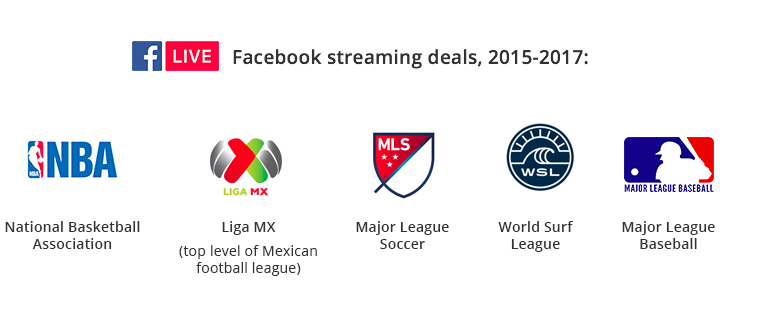
Conditions related to each of the above deals varied depending each sport’s popularity, the number of games etc. Games were usually streamed via the Facebook page of the relevant organisation, with stream sometimes limited geographically. But there’s no doubt that Facebook’s activity has started to position the social platform as a sports broadcaster in the making.
At this point, it’s worth mentioning the new Facebook platform, Watch. Launched in August 2017, it is a video service that hosts original content produced by Fox, Buzzfeed, Discovery Communications and Walt Disney, amongst others.[3]
For now, it is available in US only, but it’s only a matter of time when it will be available in other markets. Facebook Watch is undoubtedly a further, clearer statement about the company’s broadcasting future, with sports broadcasts and sports-themed shows part of its mix.
It’s not only Facebook fighting for rights
The battle for rights and ultimately audience share is not settled yet. There are many players striking deals:
- In April 2017, Amazon signed a deal to broadcast NFL games on its Prime service.
- Before Amazon, Twitter had rights to American Football, with the record game between Oakland Riders and Kansas City Chiefs watched online by 3.1 million at its peak; versus 17.4 million viewers via traditional TV. Funny fact: 12% of viewers weren’t even logged in to Twitter![4]
- CBS is an interesting example of a traditional broadcaster who’s creating a digital business in parallel. While broadcasting the NFL to its core TV audience, the channel also uses its OTT service – CBS All Access – to broadcast games digitally.
- Verizon Wireless paid $21 million for the rights to exclusively show the NFL game between Baltimore Ravens and Jacksonville Jaguars at London’s Wembley Stadium. If this isn’t absolutely crazy, we need to redefine ‘crazy’!
Why should you invest in broadcasting to social media?
On the face of it a simple question – why should you invest in broadcasting to social media? – but there are many ways to answer:
- Live video has the ability to improve all vital KPIs for social media: engagement rates, reach, views, and more.
- Online video content ad sales are growing faster than sales in traditional TV – 17% versus 4% respectively in 2016.[5]
- Younger generations are steadily moving to digital mediums as cord cutting gathers pace.
- In emerging markets like India, Thailand and Brazil, 25% of consumers are at least 14 years old, compared to 16% in developed markets. In only a few years these consumers will develop a heavier influence on markets.[6]
- For sports leagues, clubs and events outside of the top tier, digital broadcasting is a huge opportunity to engage with extremely loyal fans and reach out to new viewers world-wide. For example, the Henley Royal Regatta benefits from the innovative work of sports production company, Sunset+Vine, who use Tellyo to live stream the event to social media and create immediately shareable social video clips.
- In case of Twitter, let the numbers talk:
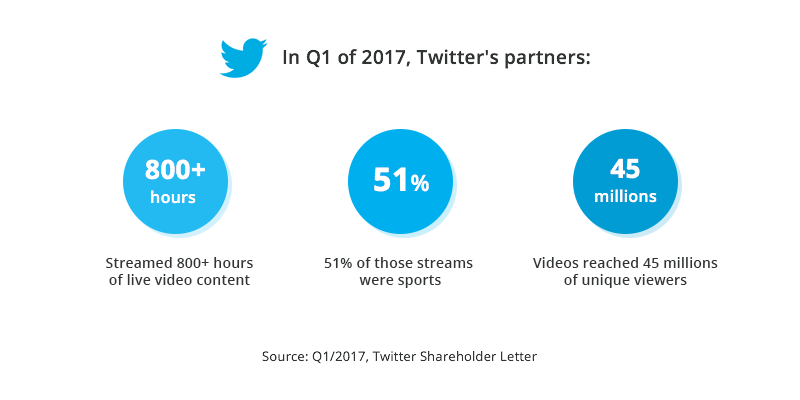
A quick note of positivity: the social media streaming market is still far from crowded and there’s plenty of room for a growth. This has never been truer for the companies, teams, associations or sport federations that are much smaller than Facebook, but who want to punch above their weight.
Social media and live sports – the perfect match
Social media platforms are natural extensions for TV broadcasters specialising in sports. But the social and online platforms themselves are muscling in, too. Big players like Twitter, Amazon and Facebook will continue to provide premium sports content to their vast audiences. They’re even proving hard to beat when it comes to buying (such as NFL streaming rights).
Yet, across the internet there’s plethora of sports fans happy to watch the sports they love. Even if not an entire game, these fans search out highlights, video summaries and blooper compilations. There is a golden opportunity to make these fans happy and show them what they want in an environment they love – the web.
So, what should you do? Simply include live streaming to social media and the creation of shareable video clips in your online strategy. And just go for it, champ!
Sources:
Brace yourself: here come the Gen Z cord cutters
The following proverb – may you live in interesting times – means a lot if you’re working in the broadcasting industry right now. In part due to new technological innovations, but also because of the generation shift currently taking place.
As Millennials get that bit older, their place as the new generation on the block is slowly being taken by Generation Z and their hard-shell habits.
The facts
Whatever you decide to call them – be it Gen Z, Generation Z, Post Millennials – they are on the rise. Here, I’m going to settle on Gen Z, the generational cohort that will hit more than 2.5 billion of the global population by 2020[1]. That’s nearly 25% of the American population. Even today, they are second biggest generation in the United States[2].
What defines the Gen Z?
Gen Z refers to people born in the late 90s – people who grew up with a mobile or smartphone in their hands, literally.
Learn more: A simple guide to targeting generation Z with videos
Gen Z spends at least one hour a day online, with almost half of them being connected for more than 10 hours every day! To make this even more complicated, they’re using many different devices, sometimes simultaneously. For many people who remember their parents telling them not to stare at the TV for too long, the stats will highlight just how different Gen Z really are.
Cord cutting
A characteristic that truly defines Gen Z is cord cutting. This generation get their content kicks from wi-fi enabled, standalone devices – often the smartphone – with the most popular platforms being YouTube, Snapchat, Instagram and Facebook. It’s no coincidence that these popular platforms are also the most popular ones for watching videos. That’s because [bctt tweet=”Gen Z loves video!” username=”TellyoTV”]But, unlike Millennials and Generation X, they consume it mostly via the web, their native environment.
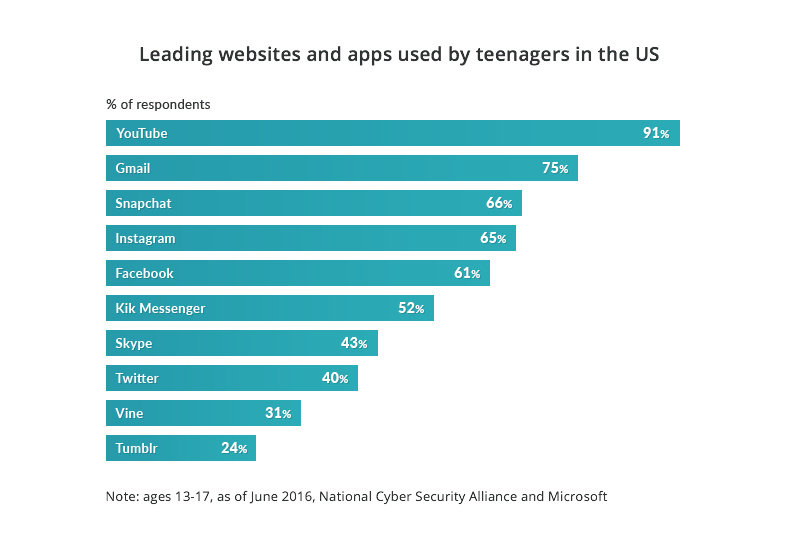
It’s not that Gen Z aren’t watching TV at all. They do, primarily because many are still living at home where their parents watch television and the TV in the living room is often a standard satellite or a cable one. A family home is also more likely to have a combined cable/internet package deal, so families are not forced to choose between just the internet or the hundreds of traditional TV channels.
Even so, Gen Z do consume entertainment in a slightly different way. Gen Z teens spend more time watching Netflix and YouTube (combined 59%) than watch traditional TV (29%)[3]. And, as Gen Z grows in size, cable TVs look to be in slow decline with the process seemingly unstoppable.
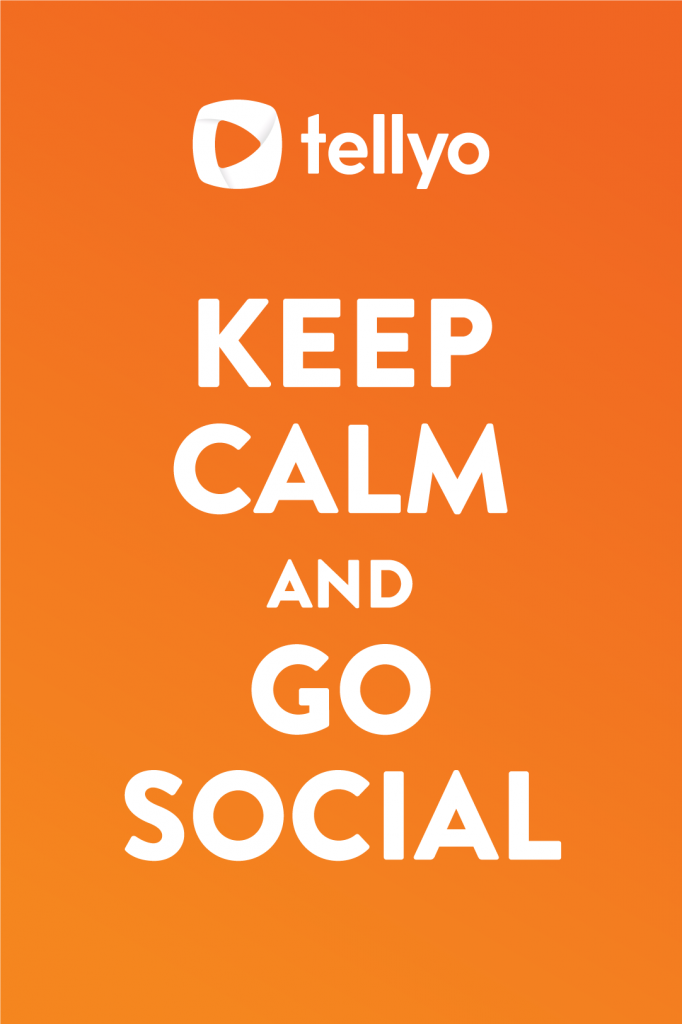
For now, most Gen Z teens are still living with parents. But soon they will start their own families and buy their first homes. At which point – Will they buy TV sets? Are they going to sign up for cable TV? Or will their behaviour be further shaped by watching music videos on YouTube, chilling with Netflix and checking the weather on a smartwatch’s screen? There are no easy answers.
Winds of change…
Just to be clear – cord cutting is not a myth, nor is it a monster that eats traditional televisions for breakfast!
It is a generational shift, influenced by many things such as technological advances, the prevalence of social media and changes in behaviour. However, it does seem that the process of cord cutting is irreversible. Something that broadcasters needn’t be afraid of, as many opportunities await.
[1]Gen Z Report 2016 by Fung Global Retail Tech August 29
[2]http://www.goldmansachs.com/our-thinking/pages/macroeconomic-insights-folder/what-if-i-told-you/report.pdf
[3]http://trifectaresearch.com/wp-content/uploads/2015/09/Generation-Z-Sample-Trifecta-Research-Deliverable.pdf
What indicates success? The social video KPIs that count
Ok, so you’ve broadcasted another video to Facebook… Surely you gained some likes, comments and shares. But is that all you should expect? What really indicates success?
To help you measure outcomes, here are the indicators you should take into account. Let’s take a closer look.
Views
These are a very informative but basic indicator. Views are the most popular way to measure the success of video content and every social platform will provide this information. But views don’t tell the whole story. They’re more like the first chapter – a small glimpse at how your video is performing. So, [bctt tweet=”when choosing KPIs for your video strategy, don’t just stop at views.” username=”TellyoTV”]
Subscribers or Followers
The name of this indicator can vary from platform to platform. However, it’s one of the most vital ratios, with the number of people following your social channels hugely impacting other KPIs. When creating a video or broadcasting strategy, you should include fan, follower or subscriber growth, and ratios to other KPIs such as views.
Learn how to incorporate sponsorship into your real-time social videos
To increase subscribers, for example, remember to use call to actions (‘Subscribe to our channel!’), or subscribe buttons within a video and a link within its description.
Drop off rate
This indicates how many people watched your video and dropped off after 5, 10 or 30 seconds. It’s absolutely natural for this KPI to drop initially during some of your first attempts at video, but there are many practical things you can do to decrease drop off rates.
To do so, you might shorten video intros and cut the length in general to condense your message.
Watch your video one more time before publishing. Ask yourself: Does it need shortening? Does it get to the point quickly enough? Where’s the beef?
Conversion rate
This indicates how efficient your content is, but it’s rarely linked with video marketing or broadcasting in general. Whether you decide to include in your KPIs will depend on your goals. For example, if you wish to increase the number of subscriptions to your video service, and video is your main content, you may want to include this KPI in your quarterly or yearly marketing strategy.
You can convert viewers into subscribers, or even new customers, in many ways:
- Include call to action buttons in your videos. Play with the copy and design to test what works best for you.
- Remember to add call to actions and links with your video descriptions too.
- Use specially created email addresses and phone numbers to measure the direct impact of your videos on business enquiries.
It’s up to you!
No matter what set of KPIs you decide to measure, always give yourself time.
Collect the data over a reasonable period, which will enable you to see the whole picture and insightful patterns.
If you’re already using Tellyo – check out our Analytics section to see insights related to your content. Using our platform you also have access to other features, all of which are designed to make your content better and more attractive to viewers… so helping to boost your KPIs.
Going social with your broadcasts: the basics
Back in the day, when Facebook was on the rise, every business owner wanted to be there ‘because everyone’s there’. The social network was soon flooded with aesthetically poor and awkwardly positioned business profiles, most of which were instantly forgotten.
The lesson we can all take from back then, at the beginning of the Facebook hype, is that it’s not enough to just be in the right place. In order to gain social media results, you need to remember why it’s good to be there and how to do things right.
So, let’s start with some basics, so you can ensure your video presence on social media is professional, striking and memorable.
Social media broadcasting is dialogue
Many organisations deciding to make the leap to social media often forget one basic principle: social media is all about dialogue between brands and fans.
So, when you start posting your videos to social media, don’t be surprised by the amount of feedback you receive. It’s not enough to simply stream great content, you must be prepared to handle the reactions of your community – positive or negative.
Prepare your social media team to expect the unexpected, such as difficult questions, spammy comments and harsh language, much of which you’re likely to encounter.
Roll with it… it’s not a such a bad thing
A traditional broadcast is controlled by a TV station, while video on social media can develop a life of its own even after being broadcast to a social channel. Once transmitted to the web it could be re-shared thousands of times, rippling out to more and more fans in the process.
What this does raise are questions about how to ensure your branding remains while your content extends its reach. The good news is that there are many useful things you can do to protect and secure branding on your content, such watermarks and bumpers.
Protect your rights by branding your content with watermarks, overlays, wipes and bumpers. Tellyo can help you to do this.
Broadcast is dead, long live the broadcast!
In the world of social media, a broadcast is not a singular event. From broadcasted content, you can create multiple, independent video clips for different social channels, different time zones, and in different languages for different audiences. You can recycle content by creating clips, highlights and compilations.
Thanks to Tellyo, you can even create cool clips during a stream; while also being able to create longer video compilations by joining clips from your live stream with older content created from other sources.
Let your social media folks get creative and play with content. Bring it to life one more time!
Timing is everything (duh!)
In professional broadcasting, especially in sports, timing is crucial. Being able to clip and share a replay to Facebook and YouTube is everything. You can be sure that the first brand to replay a goal or a golden moment will build more reach and grab new viewers within seconds.
If you can automate content production to gain speed, don’t hesitate to do it. In Tellyo, for example, you can ensure branded bumpers are immediately added to all content as part of your workflow.
One more thing…
There’s no simple or perfect recipe for success. Just be prepared and open minded.
If you’re looking for a tool that will help you quickly move beyond the basics and reach new heights with social media, check out Tellyo’s features and our case studies.
Digital video publishing: big challenges, simple solutions
Digital video publishers have spoken about the challenges they face in an insightful report from Wibbitz: Winning strategies for digital video.
Through its findings, having surveyed the company’s American and European publishing partners, Wibbitz have been able to identify the challenges proving hardest to overcome.

But for every challenge faced, there’s always a solution. And here I want to look at the top four challenges, and how our Tellyo platform can help you overcome your pain by offering some simple fixes.
Human resources
The major challenge for many video publishers is simply having people in place to produce and distribute content. The reality of many people being involved in video production may sound familiar to you? It’s something we often hear from businesses here at Tellyo.
Potential customers often tell us how they have separate teams for production and for social media, all trying to manage a technically demanding process. Our response is always the same: it needn’t be this way.
Our Tellyo platform democratises video editing, negating the need for tons of specialist and expensive kit, while making the whole process easier and quicker for your people to manage. Tellyo will make video publishing easier and less resource consuming, but not less powerful. Ultimately, you will be able make more brilliant content with the same human resources.
Monetisation
You may be finding that it’s pretty easy to reach decent levels of video views, since platforms like Facebook clearly favour video over other content types. But what comes next? What to do with your hundreds, if not thousands, of video views? Well, you’re not alone in asking such questions. Monetisation was the second biggest challenge highlighted by Wibbitz survey respondents.
With Tellyo, you can monetise your video content very easily using our platform’s features. These include pre- and post-roll advertisements, and branded video players. All of which can be included when you share video content or stream it to different social platforms via Tellyo.
For businesses that are not yet utilising video content – if you move swiftly, you will boost your chances of capturing the attention of new and existing audiences through the video content they desire. This will help you to create monetisation opportunities further down the line. Which leads nicely to my next point…
Quantity and scale
Because there’s huge demand for video online, businesses want to be able to deliver the quantity and scale that’s required. To cut a long story short, Tellyo helps you to scale production in a very short space of time. For example, our easy to use workflow can be rapidly integrated into and adopted by a business.
Quantity is also extremely important. As an example, let’s take a look at an analysis of one of our customers, the International Table Tennis Federation (ITTF).
There’s strong correlation between number of videos shared by the ITTF and engagement rates:
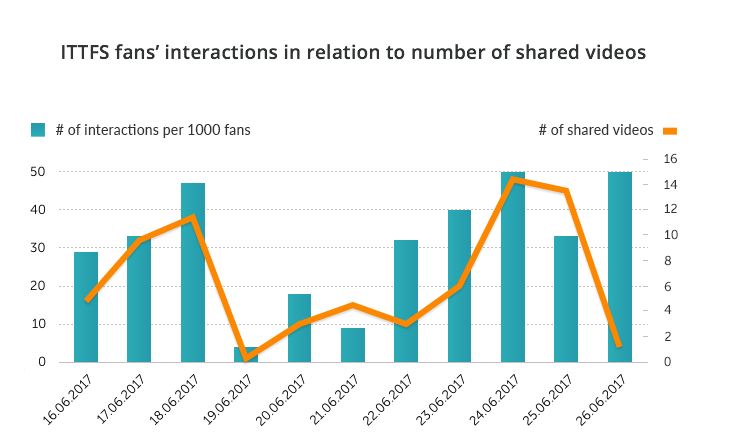
Simply put: the more you share, the more likely you are to achieve greater engagement.
Maintaining quality and standards
It can be a challenge to pay attention to quality if there’s no time to waste and your main competition never sleeps. Tellyo addresses this by delivering tools that help maintain fast-paced video production, while empowering you to communicate a consistent and coherent brand story through well-packaged videos.
To do so, we make it easy for your team to work together. Using highly-reliable Amazon solutions, Tellyo is cloud-based platform which makes it easy to access for the people involved in a project. What’s more, our platform makes it possible to fit video production to the different software and hardware requirements you might be working with. This means you can provide high-quality content fitted to different standards and expectations.
For example, Tellyo can digest various sources, such as HLS, RTMP, satellite streams and TV Exchange Points. It will also work with the most popular social and video networks, like Facebook, YouTube, Twitter, Instagram, but also Brightcove or custom destinations.
When it comes to working with our customers, we’re pretty flexible here at Tellyo.
We’re always open to new challenges and more than ready to provide solutions fitted to the specific challenges you face. Our platform is also geared towards empowering you as a digital video publisher, so you can focus on the quality of your content, rather than on technical or organisational obstacles.
Please get in contact to discuss your challenges and how we can help.



